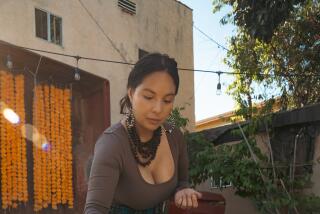Island Chocolatier
- Share via
Jim Walsh is sitting around at a Beverly Hills hotel, wearing a Hawaiian shirt and offering people chocolate from his own cacao trees. He got here by accident.
A car accident, that is--a serious one he suffered in 1982. As he lay in the hospital, he decided not to return to his high-pressure communications and advertising business. He would live the good life on the island of Hawaii instead.
If he could come up with a way of making a living there, that is. When he visited the Big Island, all he found were pineapple and sugar, both declining industries.
But back on the Mainland, an employee of Hershey Foods suggested that he raise chocolate in Hawaii, which is free of the diseases and insect pests (not to mention the civil wars) that threaten the future of chocolate in Africa.
So Walsh moved to Hawaii in 1986 and partnered with Hershey for four years developing disease-resistant cacao tree strains. They experimented with crossing 134 varieties of tree and came up with the first new cacao variety in 80 years.
Not that disease resistance is needed in Hawaii, not yet: Black pod, monilia fungus and the other pests haven’t reached the Islands. So the only chocolate raised on American soil is also 100% organic. “I went organic,” says Walsh, “because there were no pests there anyway.”
Conveniently, the decline of the sugar and pineapple industries has made plenty of land available. Some of the plantings are on lava fields. “They’re very rich,” Walsh says. “You’ve just got to be sure the tractor doesn’t fall through into lava tubes.”
Though he hasn’t met his goal of a million cacao trees by this summer, Walsh claims 285,000 trees in production and 155,000 more planted. “Eventually, we could supply as much as 10% of American demand,” he says. “We’re aiming at the 4% to 10% spot.”
Walsh “roasts” the cocoa pods by simply letting them sit in the sun for 30 days. “They’re surrounded by a sweet mucilage which ferments and gets the temperature up to 120 degrees, which is high enough to roast the flavor,” Walsh says. “The main reason for [oven] roasting is just to get the skin off the nibs.”
After fermenting, the pods are dried and aged for about a year, which is why Walsh’s brand is called Hawaiian Vintage Chocolate. Walsh claims that aging for as much as two years mellows the flavor of chocolate. The final production--grinding, conching and tempering--is done in Northern California.
So far, he has been selling his chocolate mostly to restaurants--Paul Bocuse, Roger Verge, Rick Bayliss and Emeril Lagasse are among the chefs who use it. In California, it’s sold only at Whole Foods Markets in the Bay Area.
Meanwhile, Walsh has put off the good life. “I planned to live in Kona, maybe ride around on a tractor and pick a few pods,” he says. “Ironically, the business requires me to live in the city, in Honolulu.”
Hawaiian Vintage Chocolate can be ordered the Internet at https://hwvi@hwvi.com or by phone at (800) 429-6246. The bittersweet Kona and Kea’au brands (64% cocoa mass) are $40 and $32 a pound, respectively. The semisweet Pahoa (56% cocoa mass) is $28 and the white Snows of Mauna Kea (35% cocoa butter, 61% caramel) is $24. Add $5 shipping per order up to two pounds. You can order by half- and quarter-pound as well. All chocolate sold as pistoles (small coin shapes) for cooking purposes.
More to Read
Sign up for The Wild
We’ll help you find the best places to hike, bike and run, as well as the perfect silent spots for meditation and yoga.
You may occasionally receive promotional content from the Los Angeles Times.






